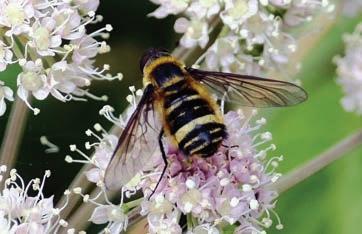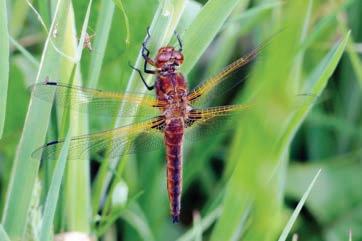
6 minute read
New Arrivals in Herefordshire 2022 David Taft
New Arrivals in Herefordshire 2022
- David Taft
Advertisement
This year two new insects have turned up in my part of Herefordshire, one being entirely new for the county. Since the start of the 21st century an increasing number of insects have appeared in Herefordshire for the first time, and are now establishing themselves as part of our local fauna. This is due to range expansions in a northerly and westerly direction, which is thought to be at least in part due to climatic changes. These new species I recorded are the Scarce Chaser (Libellula fulva) and the Downland Villa (Villa cingulata). This is part of a general trend amongst fauna and flora that seems to have been gathering pace over the last 20 to 30 years or so, and the following examples of this are species that have reached us from the continent over this period. The now well known Tree Bumblebee (Bombus hypnorum) appeared in Wiltshire 2001 and has quickly spread northwards and is now widespread in Britain. It usually nests in holes in trees, but has become familiar to many people when it has used a bird nest box as a suitable alternative. The less well known Saxon Wasp (Dolichovespula saxonica) is a typical black and yellow social wasp, which I suspect is often seen but not recognised as it looks so very like our native social wasps. It was first seen in Surrey in 1987 and is now widespread in both the county and Britain. Various bugs like the bright red and black Cinnamon Bug (Corizus hyoscyami) and the Tortoise Shieldbug (Eurygaster testudinaria) in shades of green and brown have recently spread north from localised areas of southern coastal England. They have become well established in the county and the Midlands generally over the last 10 to 20 years. The Dotted Bee-fly (Bombylius discolor) also appeared locally in the last decade or so, spreading from a small area of southern coastal cliffs, chalk and limestone grasslands. It is easily overlooked as it is similar in size and has the same general colour as the widespread and common Dark-edged Bee-fly (Bombylius major). Both species fly from March onwards and frequent similar habitat, so the new arrival has probably been overlooked and underrecorded.
This brings me to the Downland Villa (Villa cingulata), another member of the Bee-fly family (Bombyliidae), which is both distinctive and is seen in summer, making it easy to identify. The Downland Villa (Villa cingulata), is one of three species in its genus; but the other two whilst similar have very limited coastal distribution and very specialised habitat requirements and so seem unlikely to ever arrive in Herefordshire. It appeared for the first time on the Herefordshire side of the Malvern Hills in summer 2022, in a small meadow surrounded by trees in an area known as Evendine. It differs from the two typical spring Bee-flies mentioned above as it has distinctive abdominal bands, although it is of similar size and has the typical brownish furry appearance of these Bumblebee mimicking flies. I had been looking out for the Downland Villa since I had recorded it at St. Wulstan’s Local Nature Reserve on the Worcestershire side of the Malvern Hills, several years ago. I visit this location regularly as I undertake a weekly butterfly transect for Butterfly Conservation, and it is less than 10 minutes from my home on the Herefordshire side of the hills. The Downland Villa was until recently described as rare and confined to localised Limestone grasslands of southern England, with a few in the southern Cotswolds and Chilterns. In the 19th century some authorities thought it might even be nationally extinct. As recently as 2018 this species was recorded at White Rocks nature reserve in the Doward which was a former Limestone quarry site and is now grassland. This is a long way from the Malvern
Hills, where I have recorded it on both sides in grassy areas surrounded with trees on neutral/acidic loams and certainly not the Limestone/Chalk grassland that is supposedly its preferred habitat, and gives it its name. Perhaps like the spring Dotted Bee-fly mentioned above, it has adapted to a more general grassland habitat than purely Limestone downland. At St. Wulstan’s LNR I have observed them basking on the old ant hills formed by the Yellow Meadow Ant (Lasius flavus), where open areas of unimproved grassland exist. But, like many insects it loves to feed on umbellifer flowers as shown in the photograph below, and this makes it easy to spot and photograph. So, as this insect is now appearing in unexpected places other than Limestone downland, it is well worth keeping an eye open for this distinctive furry fly, which is around 10mm long (slightly less than ½inch), anywhere you find umbellifers in grassland.
The Scarce Chaser (Libellula fulva) has an even more dramatic story. As can be seen from its name, it was until the early 2000s a ‘scarce’ species limited to slow flowing rivers and drainage ditches in the south-east of England. Since then it has spread rapidly; in fact faster than any other species in its group. It had been known from the river Severn and the gravel pits adjacent to the river at Ripple for quite a few years. So, although not far away it was a surprise when it appeared on the Cradley Brook in spring this year. The Scarce Chaser had obviously made its way around or over the Malvern Hills one or two years previously, as the specimen was immature having just hatched from the brook where it would have lived as a nymph for one or two years. So, a female would have laid eggs in the water in either 2021 or 2020. The Cradley Brook is a series of slow flowing streams meandering around the parishes of Mathon and Cradley before reaching the Leigh Brook and eventually the River Teme. This discovery was made on a cool dull day and the Scarce Chaser was sitting on some
Downland Villa (Villa cingulata), female, 26th July 2022
set-aside vegetation a few metres from the water which was only a couple of metres wide and almost jumpable by a fit young person. The water varied from a few centimetres to a metre or more in depth as it flowed around the meanders. Although blue damselflies and demoiselles are common in stretches of this small brook, it seemed an unlikely home for this medium sized dragonfly, around 45mm long (1¾ inch) long. Immature adults after emerging start off with an orange-brown coloured abdomen with a darker brown stripe, which in the specimen pictured is starting to turn blue and will eventually in a week or two turn entirely a bright powdery blue. The females become a dark olive brown. The dark stain at the base of the wings is diagnostic for this species, and sometimes the tips of the wings have a dark smudge mark, but this is not the case in the photographed specimen.
So, yet another insect that may turn up almost any where there is relatively clean fresh water, either still or gently flowing, although it does not like too shady an area. This insect is known as the Blue Chaser across Europe, and it may be appropriate to adopt this name in the future as hopefully the name Scarce Chaser will become an inappropriate epithet. Scarce Chaser (Libellula fulva), immature male, 20th May 2022











